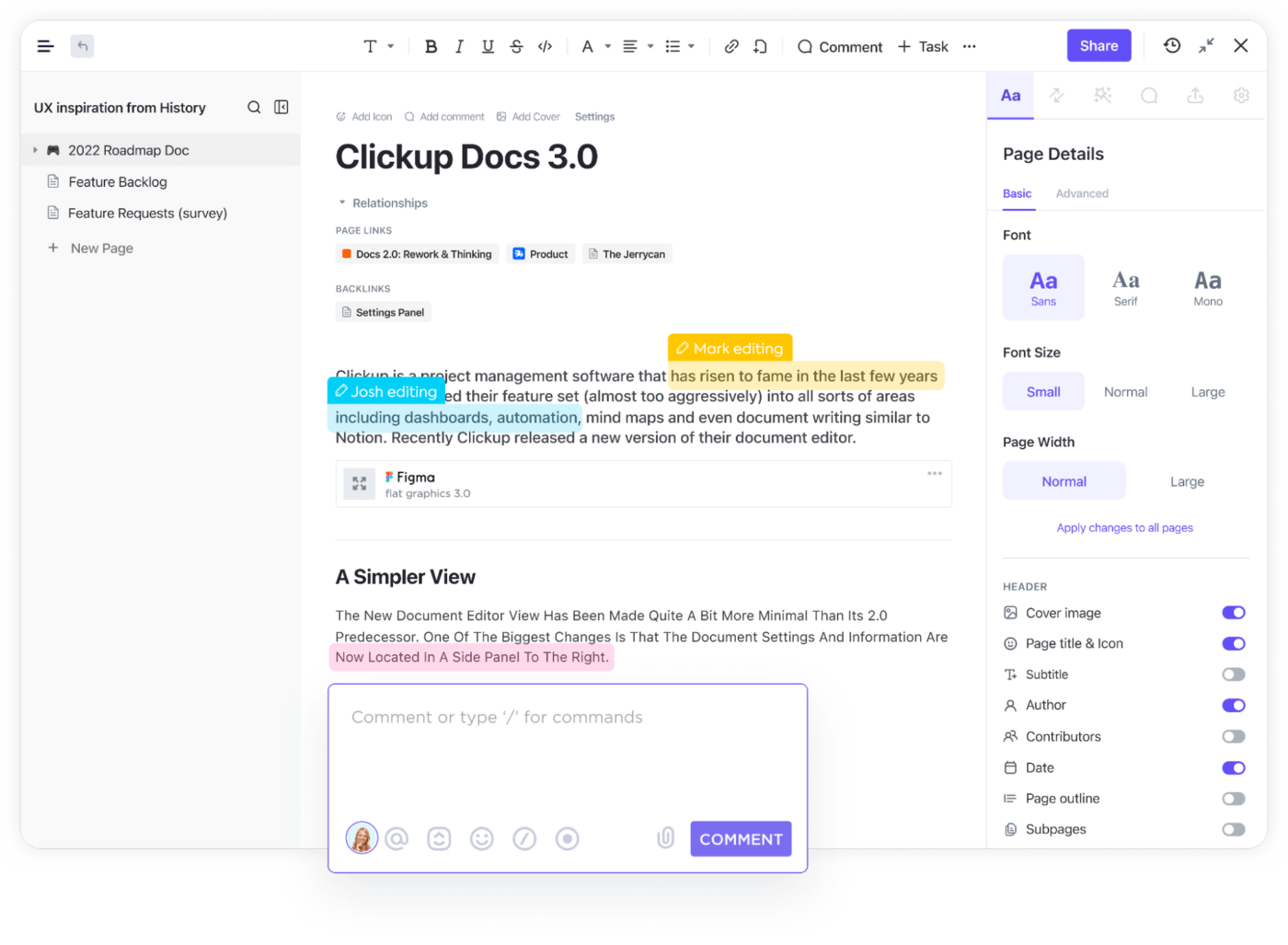Agile Documentation: What Is It and How to Implement It into Your Projects

Sorry, there were no results found for “”
Sorry, there were no results found for “”
Sorry, there were no results found for “”
There was a time when software development and documentation processes were rigid and inflexible.
Then came the Agile Manifesto—it minimized the initial documenting requirements and emphasized direct collaboration between stakeholders. 🤝
However, many software developers and project managers still need help implementing the recommended practices of this new approach, facing challenges with planning, updating, and managing technical documents.
This article will explore how teams can implement scalable and sustainable processes for agile documentation and development. We’ll also introduce you to a powerful tool that can guide you every step of the way!
Agile documentation is a method of creating and managing project and software documentation following the principles of agile development. It involves creating concise and easily understandable technical documents, departing from the traditional long and overwhelming formats. 🗒️
Agile documentation implies following four primary principles, which prioritize choosing:
Here’s what each principle relates to and how you can put it into practice:
Instead of taking a rigid and sequential approach to creating documents, the agile method promotes regular interactions between individuals involved in projects.
All stakeholders—including project owners, managers, development team members, and documentation writers—hold regular sprint ceremonies and meetings to decide which project processes or parts of the software need to be addressed in a particular sprint.
Regular communication allows your team to decide on and document the scope of each project duly.
The Agile Manifesto encourages delivering small parts of working software in shorter iterations instead of bigger portions requiring comprehensive documentation. Task segmentation gives customers a sense of continuous progress and peace of mind.
Instead of negotiating a Software Requirements Specifications (SRS) contract with customers, the agile method calls for establishing channels for direct collaboration to allow stakeholders to communicate any requirement changes proactively. This agile approach ensures the product developed meets customer expectations.
The final principle relates to being flexible enough to respond to changes instead of following rigid software development plans that can’t be adapted quickly. This principle calls for greater flexibility in planning software functionality, which, in turn, leads to flexibility in technical documentation requirements.
Instead of creating long and extensive documents detailing each agile software development process and step, focus on covering the primary requirements, leaving out the exact methods to make room for any necessary changes.
The Agile Manifesto doesn’t put too much stress on detailed documentation. Instead, it states that the only measure of project progress is working software, and the most effective method of conveying information is conversation. 🗣️
Going by that philosophy, the project owners would convey their requirements directly to developers, who then try to implement them in smaller iterations.
But reality is not as simple. New practices have emerged, making documentation an essential part of an effective operations strategy, albeit in a slightly different manner. Here’s why it matters:
While concise and neat, agile documentation must fulfill specific quality requirements to provide the most value. There are five elements any agile documentation should contain to achieve its objectives, and they are as follows:
With all this in mind, let’s go over the steps you should take to make agile documentation an easy and streamlined process—the way it was intended to be! 🎯
Smooth and successful agile documentation requires a system that allows project managers to participate in all sprint meetings and daily stand-ups between project owners and the development team. However, interaction should not be limited to meetings, and the team should be able to connect at all times.
A great way to do this is by relying on management and productivity platforms to do the heavy lifting.
ClickUp is a go-to platform for such tasks. You can use the ClickUp Agile Project Management Suite to manage product roadmaps, backlogs, and sprints. During the whole process, use the Chat view to communicate with your team within a shared conversation, which you can access or leave whenever you want.
Now that we know the basics, let’s go over each step of the documentation process! 📃
Anything worthwhile begins with a plan, and writing documentation is no different. The sprint planning ceremony marks the beginning of the process. It involves software developers, managers, and project owners sitting down to decide the software iteration that will enter the development pipeline in any particular sprint.
Team members responsible for project documentation should participate in sprint planning ceremonies to stay on top of the features developed and their basic requirements.
Once onboarded, you can use ClickUp Goals to set clear targets and estimate timelines for completion. Here you can categorize different software features or project requirements using Folders and check their progress in percentages. 📈
After you set eyes on a target, you can use ClickUp Sprints to line up each segment that needs documenting according to the sprints scheduled for the entire week or month. All you have to do is create the task and mark it as To Do, and you’ll have a clear overview of scheduled processes.
To keep all your team’s work synchronized, use one of many ClickUp integrations, like:
Any uncompleted task will automatically move to the next sprint, allowing you to track delays in the software development and plan writing continuous documentation accordingly. ✍️

For a broader overview of the project, you can leverage some of ClickUp’s 15 views. For instance:

The sprint backlog is a document that captures all the features, enhancements, bug fixes, and other work items that the software development team needs to address in the following sprint. An essential aspect of building sprint backlogs is documenting everything clearly and concisely—allowing the document to evolve along with the product and its requirements. 🌱
By documenting all essential tasks promptly, you ensure:
To do this, you can use the ClickUp Sprints—go to your sprint and sort the tasks by due date and task status. You’ll be able to see all your backlog items at once and quickly decide which ones need your attention based on priority. As you work and complete your pending tasks, you can check them off the list.

If Sprint lists are not your preferred way of managing backlogs, use some of the following agile templates:
These templates allow you to record a delayed item’s impact, the effort required to complete it, current progress, the process summary, and much more.

Agile projects are dynamic and iterative, so documenting each part of the process as it progresses is the key to having up-to-date information. 🗝️
Client requirements may change during the software development phase and your documentation should reflect those changes. Regular updates also ensure faster launching of each feature as it prevents unnecessary holdbacks.
With ClickUp Docs, you can manage updates in a breeze—edit documents in real time along with your colleagues or use the Focus Mode to concentrate on writing down the current update without distractions.
You don’t have to do anything from scratch. Choose from ClickUp’s library of over 1,000 templates to draft all documents effortlessly and save valuable time.

You can start with the ClickUp Project Documentation Template—use the dedicated fields to note down all the specifications and other relevant information like project members, their place in the team, or the scope of documentation.
Once you’ve written down all new information, you can tag any relevant team members through comments or @mentions, and they’ll receive a notification.

To make the process even easier, use ClickUp AI for suggestions on how to document the requirements of a software iteration. All you have to do is supply some basic information regarding its functionality or how it has been changed—no need to struggle writing whole sections of technical jargon by yourself.
Once you put down on paper how a particular feature needs to work, you can quickly generate essential document elements, such as:
You can do this by sending a prompt to ClickUp AI, and it will do all the heavy lifting for you. 🏋️

Sharing your documentation effort with stakeholders ensures transparency and gives you time to make any adjustments promptly. The project owner and the investors typically want to be in the loop about resources spent and team performance. Agile documentation can paint them a clear picture without burying them in heaps of paper. 🖼️
You can automate these processes by creating custom operation dashboards, helping stakeholders visualize all finished and pending tasks. The ClickUp Dashboards rely on cards you can adjust to fit any project or process. For example, you can use:
Once you’re happy with your document, create an internal link accessible to users within the organization only. You can safely share it with any of your colleagues and get their input if needed! 🔒

Bonus read: You can create a Google Sheets database where you update all the publicly accessible documentation links as soon as you finalize them. Create user stories and documentation guides and share them with your customers, or break down the newest features and properties.
As you continue to write and deliver documentation for your projects, you’ll better understand what processes take too long and how to upgrade them. Doing this will help you optimize processes and improve your project management methodologies. Strive to evaluate:
As you steer away from overly detailed and time-consuming documentation, you leave no room for excuses when it comes to poor data organization. All relevant team members and stakeholders should be able to find needed information.
Luckily, you can use ClickUp to simplify this process—the Universal Search feature lets you browse thousands of documents, tasks, chats, or Dashboards in seconds. You can search for keywords or even dates of last updates or reviews.
Most importantly, ensure your documentation doesn’t take a lot of energy and time. Establish which tasks are recurring and leverage ClickUp Automations to expedite the processes. You can set up custom or pre-built triggers to automate actions and let the tool work its magic. For example, once the task priority changes from Normal to Low, ClickUp can archive it and apply one of the templates to give you a well-structured overview of the task.

While seemingly straightforward, navigating agile documentation can feel like finding your path through a dark maze of processes, fast-paced iterations, and ever-changing requirements. But it doesn’t have to be so bleak—you can adopt a few rules and let them guide you along the way. 🔦
Here are some simple but effective practices for documenting agile projects:
Agile documentation empowers agile teams to communicate effectively, adapt swiftly, and deliver exceptional results. With the right strategies in place, you can navigate software development without losing focus on what matters.
Luckily, you don’t have to start your journey alone—ClickUp’s Project Management Suite provides everything you may need to fine-tune your documentation processes and scale them without compromising their effectiveness or efficiency. Sign up for ClickUp for free and excel at all your projects with concise and well-thought-through documentation.
© 2025 ClickUp